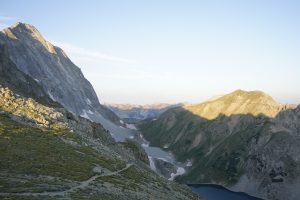Maple: The wheel, the bike, and the motor

Wiley Maple/Courtesy photo
Five thousand five hundred years ago, a small revolution began, but it would be generations before it changed the face of the earth — the wheel, invented in 5,525 BCE in ancient Mesopotamia (modern-day Iraq), became the potters’ delight, drastically changing the speed and precision of pottery. Today we have such a plethora of vessels that we hardly notice — glass to plastic, steel to cast iron, even the eccentric wood creation. But for most of human existence we relied primarily on clay work. We stored our food, carried our water, fermented our wine, and built our cities with the stuff. It was such an essential piece of civilization that it’s hard to quantify. While today we’ll accept the lopsided mug from a friend who just took up a pottery class — in ancient times it was an integral piece of everyday life. The wheel is estimated to have accelerated the production and quality of clay work by up to 50%, at least, after the amateur got the hang of it — spending many a frustrated night destroying their wheeled clay creations against the wall.
It would be another 300 years until some frustrated potter kicked over his spinning wheel — watching, jaw dropped, as his wheel rolled and bounced down the street and out of sight, prompting the bright idea of turning the wheel vertical to mitigate transportation. (At least you could imagine.) For the next several thousand years, humans bumped and bounced along on wooden wheels as our children no doubt squealed. Around this time, we start to see the first roads emerge to enhance the speed and comfort of our wheeled contraptions. Though Rome would conquer most of Europe for a variety of reasons — their reinvention of the road is estimated to have been 25% of the puzzle. Using multiple layers of material for drainage and durability — straighter routes and road signs — Rome would connect the world like never before, making land transportation faster and more reliable than ever. Today, 24 million–40 million miles of road have changed the face of the Earth.
And so we were dragged or pushed — by horse and by ox for the next several thousand years — until in 1769, Nicolas-Joseph Cugnot of France invented the first machine-powered vehicle: Fardier à vapeur — a tricycle with a steam boiler — driving a single piston into the drivetrain and then onto the wheel to transport military artillery at a staggering 2.5 mph. It would be another 48 years before conveyance (outside of skiing and horse riding) became fun — when one fateful day in 1817, a German would change the bump and grind of transportation to inspiration: Karl Drais invented what would become the bicycle! The Draisine, which was essentially a strider bike (sans pedal), also known as the running machine or hobby horse — made sport out of our daily commute. Over the next hundred years, from Scotland to France, ingenious hobbyists would add components like pedals, chains, and gears — of course, our friend Goodyear added the rubber tire until finally, the bicycle arrived as we know it today.
Shortly after the original beer-powered bike (aka man-powered), someone attached a steam motor in the USA (which didn’t catch on) — for it would be another 20 years until the combustion engine was welded to the frame, creating the first motorcycle in 1885. Coincidentally, John Kemp Starley’s safety bike (the bike we know today) arrived the same year, exploding cycling into the world. Safer and cheaper than horses or eventually cars, the working and middle classes relied heavily on the bicycle for most of their daily needs. For the next 50 years, nearly everyone rode a bike, especially in countries like Denmark, the Netherlands, and China. It would eventually even become the feminist symbol for freedom. In short, it was a match made in heaven …
That was until, by the 1950s, especially in America, the automobile would come to dominate our roadways and infrastructure. And so for the past 75 years, everything automobile has come to dictate almost every facet of our infrastructure. Parks and greenery have been stripped to make way for highways and byways. Cities have become so polluted and devoid of greenery that they resemble some apocalyptic nightmare — and up to 50% of our usable space has been set aside not for housing, gardens, or farms but for another road or parkade.
But today, people are pushing back, from Paris to Bogotá, Oslo to Montreal. Forward-thinking cities are re-greening in an effort to reclaim land and health lost to the automobile, which causes approximately 1.19 million deaths a year — while simultaneously contributing half of our global transportation emissions each year… but there is a solution — well, many — but at least one that is fun. The bicycle, and I dare say, the enhanced bike — e-bike for short.
The electric bicycle was originally invented just 10 years after the motorcycle in 1895. But it did not become popular or reliable until the trusty Japanese undertook the challenge when Yamaha introduced their first e-bike in 1993, and for the last several decades, it has been creeping slowly toward significance. But it would take a global pandemic to explode its relevance unto the earth. And now it seems we’ve just reached the beginning of a new era. Many “purists” (myself included) have been resisting the change for years. But “resistance is useless” — they are here and they are awesome. As the old adage goes: adapt or die.
Today, the bicycle remains the most efficient form of human transportation, equivalent to 1,000–3,000 mpg depending on the rider. But the e-bike comes into a close second at 1,000–2,000 mpg, and with some parents stacking three deep on the back of an e-bike, a 50% efficiency is gained per human transported. The technology and efficiency of the electric bike have grown so fast that their sales have already surpassed analog bikes over the past three years. Soon, those on a classic mountain bike will find themselves in a niche sport as the e-bikes come to dominate most riding, regardless of the attempted fines and trail limitations — they will become too good not to use, with a range and suspension system giving them access to even our hardest trails — especially those long grinds that we only muster the courage to conquer once a season. The skills of e-bike riders will progress at a staggering rate — as they’ll double or triple the miles of an acoustic rider. Eighty year olds will be able to ride trails they haven’t been able to access in 20 years, and they’ll be able to do it with their grandkids. This change is already upon us — whether we like it or not, there is no going back. This change is already happening — like it or not. Instead of resisting, we should adapt:
- Widen bike paths by a few feet
- Turn stop signs on bike streets toward car traffic
- Remove the ridiculous speed limits of 15 mph on bike paths (my single-speed beach cruiser goes faster). Maybe teach people to ride respectfully instead.
- Add designated uphill and downhill directions in MTB areas
- Add more trails in general … winters are only getting shorter, unfortunately! Turns out this might help!
- Reclaim urban space from cars and parking for literally anything else (except maybe those stupid painted corners) and perhaps get those lovely COVID-era patios back at our restaurants
- Maybe even require a biking test and sticker to prove you can operate an e-bike without crushing someone’s dog.
For now, do I love the idea of giving a tourist a 40-pound e-motorcycle that goes up to 30 mph to ride on an eight-foot-wide bike path, with kids, dogs, and pedestrians when they haven’t touched any type of bicycle in a decade? Certainly not. Do I like the prospects of getting from Aspen to Highlands with my skis, boots, and poles on an e-bike in the same amount of time it takes to drive and half the time to bus… mmm, quite.
The fact of the matter is that the E-bike is a solution — and not just to one problem. Already, a commuter can average 30 mph with pedal assist from Basalt to Aspen, making it just 14 minutes longer than driving (and that’s only with open roads). According to a 2019 survey, 20–47% of European commuters are already considering switching to an e-bike to get to work and pick up their groceries. Turns out you don’t need a 5,000-pound SUV to pick up a new Louis Vuitton purse. And yet, at the moment, this is a change many are fighting — but which we should embrace — and adapt to wholeheartedly. The other day, a friend said they couldn’t wait for the Star Trek, esque transporter — I retorted: only when necessary, for most forms of transportation have become my favorite sports. … From the ski to the bike to the board, they are the instruments that let us soar. So let’s teach our kids, our friends, and our guests how to ride — and give them the space and infrastructure to get from here to there. (And let’s hold the glare.)
“Every time I see an adult on a bicycle, I no longer despair for the future of the human race.” — H.G. Wells
World Cup and Olympic skier Wiley Maple was raised in Aspen.
Stranded, injured climber rescued on Capitol Peak
Mountain Rescue Aspen has successfully rescued a climber on Capitol Peak after they were reported “overdue” by the other member of their party.










